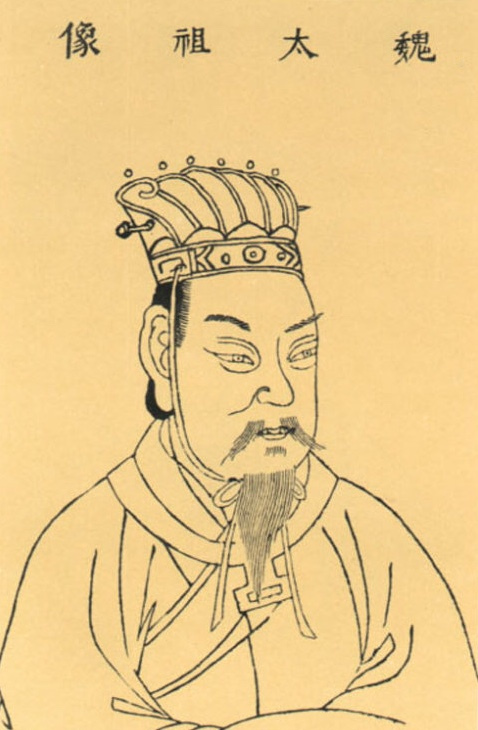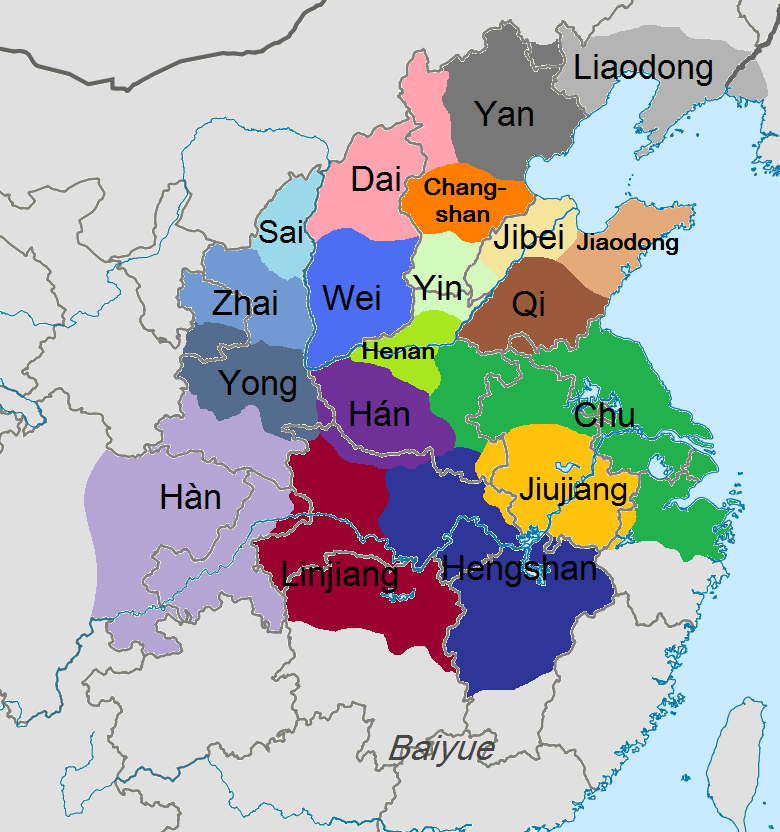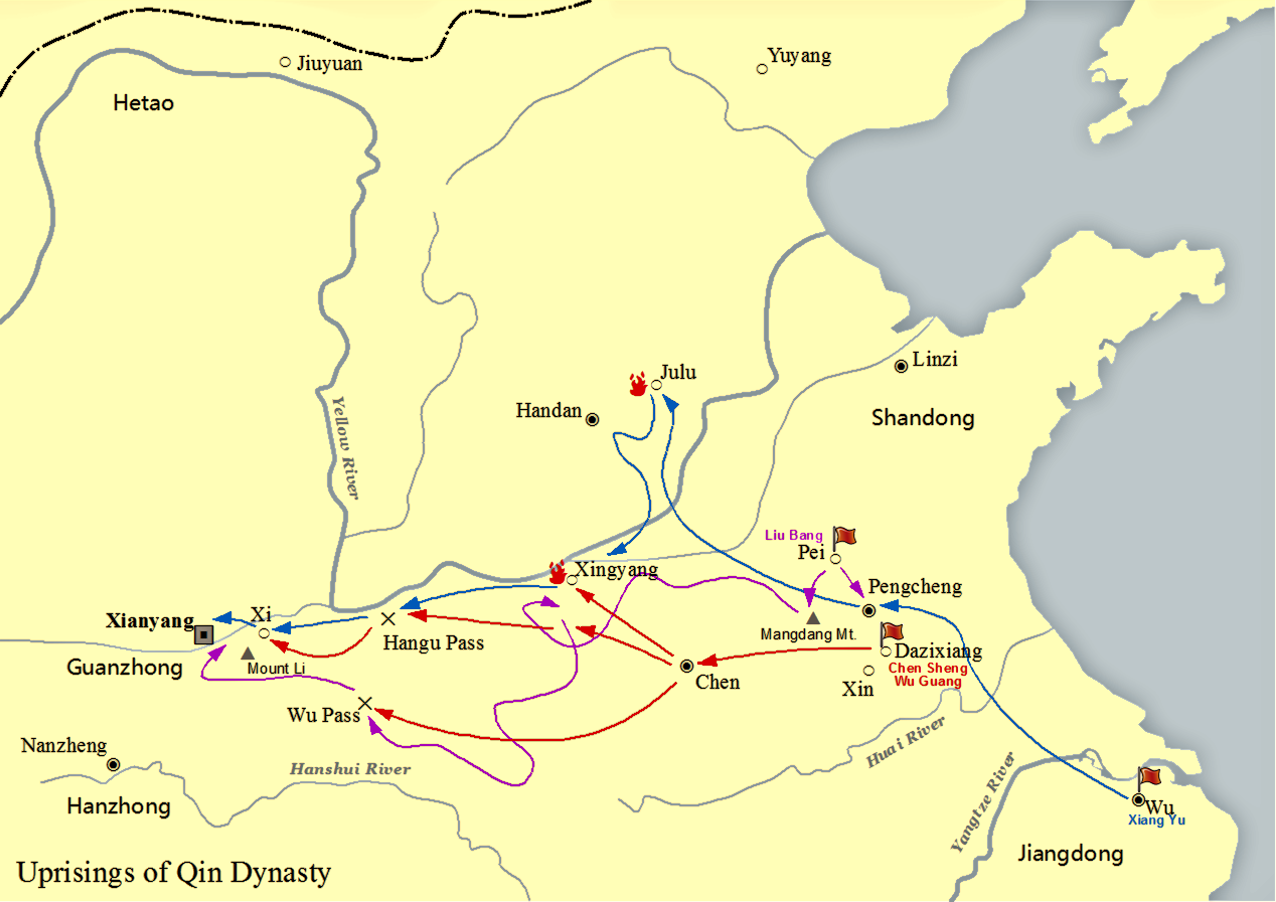|
Changsha Kingdom
The Changsha Kingdom was a kingdom within the Han Empire of China, located in present-day Hunan and some surrounding areas. The kingdom was founded when Emperor Gaozu granted the territory to his follower Wu Rui in 203 or 202 BC, around the same time as the establishment of the Han dynasty. Wu Rui and his descendants held the kingdom for five generations until Wu Zhu died without an heir in 157 BC. In 155 BC, the kingdom was reestablished for a member of the imperial family. However, the creation of this second kingdom coincided with the Rebellion of the Seven States and the subsequent reforms under Emperor Jing, and Changsha under the imperial family saw its autonomy greatly diminished. The kingdom was dissolved during Wang Mang's usurpation (AD 9 – 23), briefly restored after the founding of the Eastern Han, and finally abolished in and converted to a commandery under the imperial government. Changsha was one of the largest and longest-lasting kingdoms in Han China. Despi ... [...More Info...] [...Related Items...] OR: [Wikipedia] [Google] [Baidu] |
Chancellor (China)
The grand chancellor (''zaixiang, tsai-hsiang''), also translated as counselor-in-chief, chancellor, chief councillor, chief minister, imperial chancellor, lieutenant chancellor and prime minister, was the highest-ranking executive official in the imperial Chinese government. The term was known by many different names throughout Chinese history, and the exact extent of the powers associated with the position fluctuated greatly, even during a particular dynasty. During the Six Dynasties period, the term denoted a number of power-holders serving as chief administrators, including ''zhongshun jian'' (Inspector General of the Secretariat), ''zhongshu ling'' (President of the Secretariat), ''shizhong'' (Palace Attendant), ''shangshu ling'' and ''puye'' (president and vice-president of the Department of State Affairs). History In the Spring and Autumn period, Guan Zhong was the first chancellor in China, who became chancellor under the state of Qi in 685 BC. In Qin, during the Warring ... [...More Info...] [...Related Items...] OR: [Wikipedia] [Google] [Baidu] |
Buffer State
A buffer state is a country geographically lying between two rival or potentially hostile great powers. Its existence can sometimes be thought to prevent conflict between them. A buffer state is sometimes a mutually agreed upon area lying between two greater powers, which is demilitarized in the sense of not hosting the military of either power (though it will usually have its own military forces). The invasion of a buffer state by one of the powers surrounding it will often result in war between the powers. Research shows that buffer states are significantly more likely to be conquered and occupied than are nonbuffer states. This is because "states that great powers have an interest in preserving—buffer states—are in fact in a high-risk group for death. Regional or great powers surrounding buffer states face a strategic imperative to take over buffer states: if these powers fail to act against the buffer, they fear that their opponent will take it over instead. By contrast, the ... [...More Info...] [...Related Items...] OR: [Wikipedia] [Google] [Baidu] |
Chu–Han Contention
The Chu–Han Contention ( zh, , lk=on) or Chu–Han War () was an interregnum period in ancient China between the fallen Qin dynasty and the subsequent Han dynasty. After the third and last Qin ruler, Ziying, unconditionally surrendered to rebel forces in 206 BCE, the former Qin Empire was divided by rebel leader Xiang Yu into the Eighteen Kingdoms, which were ruled by various rebel leaders and surrendered Qin generals. A civil war soon broke out, most prominently between two major contending powers – Xiang Yu's Western Chu and Liu Bang's Han. Some of the other kingdoms also waged war among themselves but these were largely insignificant compared to the main conflict between Chu and Han. The war ended in 202 BCE with a total Han victory at the Battle of Gaixia, where Xiang Yu fled to Wujiang and committed suicide after a violent last stand. Liu Bang subsequently proclaimed himself Emperor and established the Han dynasty as the ruling dynasty of China. Background In 22 ... [...More Info...] [...Related Items...] OR: [Wikipedia] [Google] [Baidu] |
Eighteen Kingdoms
The historiographical term "Eighteen Kingdoms" ( zh, t=十八國), also translated to as "Eighteen States", refers to the eighteen ''fengjian'' states in China created by military leader Xiang Yu in 206 BCE, after the collapse of the Qin dynasty.林达礼,中华五千年大事记, 台南大孚书局, 1982, p. 56 The establishment and abolishment of the Eighteen Kingdoms marked the beginning and end of a turbulent interregnum known as the Chu-Han Contention. The details of the feudal division are as follows: The Eighteen Kingdoms were short-lived: almost immediately rebellion broke out in Qi, after which Tian Rong conquered Jiaodong and Jibei, reuniting the old Qi state. Meanwhile, Xiang Yu had Emperor Yi of Chu and King Han Cheng of Hán killed. Thereafter, Liu Bang of Hàn conquered the lands of the Three Qins, thereby formally starting the Chu–Han Contention. Following many battles and changing alliances, Hàn defeated Chu and subdued all other kingdoms, where Liu Bang a ... [...More Info...] [...Related Items...] OR: [Wikipedia] [Google] [Baidu] |
Xiang Yu
Xiang Yu (, –202 BC), born Xiang Ji (), was the Hegemon-King (Chinese: 霸王, ''Bà Wáng'') of Western Chu during the Chu–Han Contention period (206–202 BC) of China. A noble of the Chu state, Xiang Yu rebelled against the Qin dynasty and became a prominent warlord. He was granted the title of "Duke of Lu" () by King Huai II of the restoring Chu state in 208 BC. The following year, he led the Chu forces to victory at the Battle of Julu against the Qin armies led by Zhang Han. After the fall of Qin, Xiang Yu was enthroned as the "Hegemon-King of Western Chu" () and ruled a vast area covering modern-day central and eastern China, with Pengcheng as his capital. He engaged Liu Bang, the founding emperor of the Han dynasty, in a long struggle for power, known as the Chu–Han Contention, which concluded with his eventual defeat at the Battle of Gaixia and his suicide. Xiang Yu is depicted in the Wu Shuang Pu (, Table of Peerless Heroes) by Jin Guliang. Names and titles ... [...More Info...] [...Related Items...] OR: [Wikipedia] [Google] [Baidu] |
Western Chu
Chu, or Ch'u in Wade–Giles romanization, (, Hanyu Pinyin: Chǔ, Old Chinese: ''*s-r̥aʔ'') was a Zhou dynasty vassal state. Their first ruler was King Wu of Chu in the early 8th century BCE. Chu was located in the south of the Zhou heartland and lasted during the Spring and Autumn period. At the end of the Warring States period it was destroyed by the Qin in 223 BCE during the Qin's wars of unification. Also known as Jing () and Jingchu (), Chu included most of the present-day provinces of Hubei and Hunan, along with parts of Chongqing, Guizhou, Henan, Anhui, Jiangxi, Jiangsu, Zhejiang, and Shanghai. For more than 400 years, the Chu capital Danyang was located at the junction of the Dan and Xi Rivers near present-day Xichuan County, Henan, but later moved to Ying. The house of Chu originally bore the clan name Nai ( OC: /*rneːlʔ/) which was later written as Mi ( OC: /*meʔ/). They also bore the lineage name Yan ( OC: /*qlamʔ/, /*qʰɯːm/) which would later be ... [...More Info...] [...Related Items...] OR: [Wikipedia] [Google] [Baidu] |
Ziying Of Qin
Ziying, King of Qin (, died January 206 BC) was the third and last ruler of the Qin dynasty. He ruled over a fragmented Qin Empire for 46 days, from mid-October to early December 207 BC. He is referred to in some sources with the posthumous name Emperor Shang of Qin (秦殤帝) although Qin abolished the practice of posthumous names. (In Chinese tradition, even someone who never held a ruling title while he was alive might be given the posthumous title "emperor" after his death.) Identity There is no firm consensus as to what Ziying's relationship to the Qin royal family really was. He is mentioned in historical records as either: #A son of Qin Er Shi's elder brother (who, according to Yan Shigu's commentaries, was Fusu); #An elder brother of Qin Er Shi; #A younger brother of Qin Shi Huang; or #A son of a younger brother of Qin Shi Huang. While Sima Qian's ''Records of the Grand Historian'' does not specify Ziying's age, it implies that he had at l ... [...More Info...] [...Related Items...] OR: [Wikipedia] [Google] [Baidu] |
Guanzhong Plain
Guanzhong (, formerly romanised as Kwanchung) region, also known as the Guanzhong Basin, Wei River Basin, or uncommonly as the Shaanzhong region, is a historical region of China corresponding to the crescentic graben basin within present-day central Shaanxi, bounded between the Qinling Mountains in the south (known as Guanzhong's "South Mountains"), and the Huanglong Mountain, Meridian Ridge and Long Mountain ranges in the north (collectively known as its "North Mountains"). The central flatland area of the basin, known as the Guanzhong Plain, is made up of alluvial plains along the lower Wei River and its numerous tributaries and thus also called the Wei River Plain. The region is part of the Jin- Shaan Basin Belt, and is separated from its geological sibling — the Yuncheng Basin to its northeast — by the Yellow River section southwest of the Lüliang Mountains and north of the river's bend at the tri-provincial junction among Shaanxi, Shanxi and Henan. The name ''Guanzho ... [...More Info...] [...Related Items...] OR: [Wikipedia] [Google] [Baidu] |
Liu Bang
Emperor Gaozu of Han (256 – 1 June 195 BC), born Liu Bang () with courtesy name Ji (季), was the founder and first emperor of the Han dynasty, reigning in 202–195 BC. His temple name was "Taizu" while his posthumous name was Emperor Gao, or Gaodi; "Gaozu of Han", derived from the ''Records of the Grand Historian'', is the common way of referring to this sovereign even though he was not accorded the temple name "Gaozu", which literally means "High Founder". Liu Bang was one of the few dynasty founders in Chinese history who was born into a peasant family. Prior to coming to power, Liu Bang initially served for the Qin dynasty as a minor law enforcement officer in his home town Pei County, within the conquered state of Chu. With the First Emperor's death and the Qin Empire's subsequent political chaos, Liu Bang renounced his civil service position and became an anti-Qin rebel leader. He won the race against fellow rebel leader Xiang Yu to invade the Qin heartland ... [...More Info...] [...Related Items...] OR: [Wikipedia] [Google] [Baidu] |
Collapse Of Qin
The Qin dynasty ( ; zh, c=秦朝, p=Qín cháo, w=), or Ch'in dynasty in Wade–Giles romanization ( zh, c=, p=, w=Ch'in ch'ao), was the first dynasty of Imperial China. Named for its heartland in Qin state (modern Gansu and Shaanxi), the Qin dynasty arose as a fief of the Western Zhou and endured for over five centuries until 221 BCE when it founded its brief empire, which lasted only until 206 BCE. It often causes confusion that the ruling family of the Qin kingdom (what is conventionally called a "dynasty") ruled for over five centuries, while the "Qin Dynasty," the conventional name for the first Chinese empire, comprises the last fourteen years of Qin's existence. The divide between these two periods occurred in 221 BCE when King Zheng of Qin declared himself the First Emperor of Qin, though he had already been king of Qin since 246 BCE. Qin was a minor power for the early centuries of its existence. The strength of the Qin state was greatly increased by the Legalist ... [...More Info...] [...Related Items...] OR: [Wikipedia] [Google] [Baidu] |
Dazexiang Uprising
The Chen Sheng and Wu Guang uprising (), July–December 209 B.C., was the first uprising against the Qin dynasty following the death of Qin Shi Huang. Led by Chen Sheng and Wu Guang, the uprising helped overthrow the Qin and paved the way for the Han dynasty, one of China's greatest golden ages. Name It is also called: * Chen Sheng and Wu Guang Rebellion (), * Dazexiang uprising () as the uprising started in Dazexiang (大泽乡), which translates into "Big Swamp Village". History Chen Sheng and Wu Guang were both army officers who were ordered to lead their bands of commoner soldiers north to participate in the defense of Yuyang ( zh, s=渔阳, t=漁陽). However, they were stopped halfway in present-day Anhui province by flooding from a severe rainstorm. The harsh Qin laws mandated execution for those who showed up late for government jobs, regardless of the nature of the delay. Figuring that they would rather fight than accept execution, Chen and Wu organized a band of ... [...More Info...] [...Related Items...] OR: [Wikipedia] [Google] [Baidu] |






